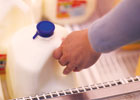
When did dairy products lose their connections with cows and become synonymous with convenience and processed foods? What happened to fresh milk, fresh cream, peaches-and-cream complexions, fresh butter, buttermilk and fresh eggs? Back when milk was delivered in glass bottles by milkmen, my father would lick his lips when he heard we were having dairy for dinner. Fresh sliced cucumbers and tomatoes mixed into gobs of thick sour cream made a favorite summer meal. While my parents ate their sour cream concoctions with pumpernickel, butter and salt, I ate bowls of berries with sweet cream and sugar. Sweet cream has been replaced by ultra-pasteurized half-and-half, and the romance of dairy has disappeared.
To be honest, the romance dissipated for me when I learned how hard and tiring it is to milk a cow by hand and realized that milking machines were at least as useful as washing machines. But when I look at the supermarket dairy case today, I see a sea of plastic packages with graphics that differentiate one brand from another, interspersed with a few paperboard egg cartons and a few more gable-topped cartons topped with colorful twist-off caps.
The packages have gotten more user-friendly and easier to open and reclose in the last decade, but today’s consumers, who are looking for packaging that is both “easy to use and eco-friendly,” don’t have much to choose from. And unless they are visiting India, where cows are still sacred, or the Stew Leonard’s store in Connecticut, where cows are part of the merchandising, they probably won’t see any images of cows unless the store they are shopping carries organic milk. Doesn’t non-organic milk still have a cow connection? Aren’t any of the other dairy products made from all-natural ingredients? If they are, why doesn’t it look that way? Natural isn’t something today’s shoppers can take for granted.
Today’s dairy cases are now full of products like juice drinks, Jell-O, Coffee-Mate, margarine, bologna, hot dogs and Cool Whip (made of water, corn syrup and hydrogenated vegetable oil) that aren’t natural and may not even have a cow (or goat) connection. The most robust products in the case have become the probiotic yogurts that seem to shout about how alive and healthy they are.
And the singular dairy case has turned into a series of perimeter and display island cases that merchandise a variety of lower-priced, mass-market, refrigerated products that compete with higher-priced gourmet and specialty food products in a nearby department where the packaging is a bit more diversified but still not very green. Neither set of cases offers anything like the pouches and reusable jugs available in other countries. And our consumers are looking for greener packaging that they can trust.
“I’m sick to death of packaging that takes up my whole trash can to get rid of it.”
“Since using cloth grocery bags, I’m more aware of all the paper and plastic that I discard.”
“A recent purchase even stated ‘less packaging.’ It was so much nicer to open!”
That last comment has one of the keys to what I found missing. Many retailers and packagers are so afraid of being accused of green-washing that they aren’t saying anything. I see much more in the trade press about reductions in packaging weight or increased use of post-consumer materials than I see in the stores or on the packages on the shelves.
At a time when many consumers want to be good citizens and want to know that their suppliers are trying to be good citizens too, there’s an information gap. In a strange and circular way, the urge to be good environmental shoppers is related to the belief that greed and selfishness caused the recession and layoffs that are touching so many people. “When so many greedy people made themselves rich by caring only about themselves, it’s more important than ever for people who care about others to do our best for the environment.”
Except for egg cartons, I don’t see any obviously eco-friendly options in the dairy case. Are there any refillables? Are there any pouches? Which packages are the most recyclable? Which are made from recycled-content materials? Shoppers who are trying to be good citizens or reduce their carbon footprint don’t know which packages to buy. I didn’t see anything in the dairy cases I looked at to appeal to eco-oriented shoppers.
A recent survey of 650 European packaging decision makers found that “retail requirements such as ‘easy to put on shelves’ and ‘space utility’ come first as a consideration.” Those were the priories I saw reflected in the dairy cases-packages that were easy to put on the shelves and had great space utility. The survey also showed that those considerations were immediately followed by environmental criteria such as “environmentally friendly,” “reduced waste,” “high percentage of recycled material” and “reduced greenhouse gases.” These increasingly important secondary considerations are not yet apparent to the shopper. Ease of putting packages onto the shelves and space utilization are important issues that impact operating costs. They are even important to shoppers who worry about what will fit in their refrigerator doors, and how much their kids will spill as they take packages out and put them back. But shoppers’ priorities are changing, and being good citizens in these troubled times means trying to do right by the environment, as well as ease of use. Packaging that isn’t connecting with what shoppers care about is only doing part of its job.

Recent Comments
Custom Boxes
You are right, this is very important before...
You can find many inspiration from Instagram app...
Check out Honista app
Great Article!